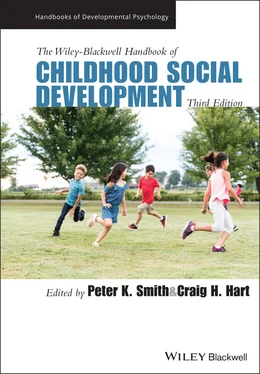Beginning in the 1950s, investigators such as Thomas and Chess (Thomas et al., 1968) utilized the construct of temperament to account for early‐emerging, stable individual differences in infants’ and children’s responses to their environments. Subsequent refinements to theory and research extended knowledge about the origins of temperament. Much of what was learned supported the hypothesis that temperament, although not impervious to environmental influences, has a genetic or neurological basis (Kagan, 2007).
Advances were made in the conceptualization of temperament, the specification of component dimensions, and the development of reliable assessments. Descriptive taxonomies (e.g., easy, difficult, slow‐to‐warm‐up) were replaced with theory‐driven models that attributed temperamental variations to specific emotional, cognitive, or behavioral processes (emotional reactivity to novel stimuli; Kagen & Snidman, 2007; effortful control, negative affectivity, extroversion‐surgency; Rothbart, 2007). Empirical work clarified how temperamental characteristics were related to other aspects of children’s social development, including their behavior, relationships, and adjustment (Rothbart 2007).
Aim 3: Explicate the nature and development of children’s internal social‐cognitive, psychological, and emotional processes
Another prominent objective was to expand knowledge about processes that transpire within the child, that is, nonobservables such as social‐cognitive, psychological, and emotional representations and processes. Largely, investigative efforts were focused on explicating theory (e.g., specifying mechanisms driving development), gathering evidence about developmental transformations (i.e., age or stage changes, growth patterns), and linking specific internal processes with other aspects of child development (e.g., behavior, health, dysfunction).
Priorities within this sphere were to further illuminate when children develop a sense of self (i.e., emergence of self‐recognition), how children revise their self‐construals with age and experience (i.e., development of self‐concept), and how children appraise their abilities and worth (i.e., self‐esteem). Findings suggested that self‐recognition emerges early (i.e., around age two) and becomes more reliable and less context‐dependent across early childhood (Miyazaki & Hiraki, 2006).
Constructivist perspectives dominated research on self‐concept and, for the most part, investigators examined stability and change children’s self‐construals using self‐descriptive tools and methodologies. Principal findings implied that children’s self‐theories become more complex and abstract as they are shaped by age‐, gender‐, and context‐related experiences (Harter, 2012).
Self‐esteem was investigated for scientific purposes and to address the popularized assumption that high self‐esteem is a prerequisite for children’s achievement and well‐being. Discoveries illuminated developmental shifts in children’s self‐evaluations, suggesting a progression from global and unrealistic appraisals during early childhood to more domain‐specific (i.e., ability‐based) and accurate appraisals during middle childhood and thereafter. Findings also revealed that children’s overall sense of self‐worth varied as a function of their perceived competence within multiple, specific domains (e.g., social, scholastic, athletic; Harter, 2012).
Potential causes and consequences of self‐esteem were explored by examining dimensions of children’s social relations and experiences. Evidence indicated, for example, that self‐esteem correlated positively with warm, affectionate parent–child relations (Ojanen & Perry, 2007), and negatively with parental abuse (Cicchetti & Toth, 2006). Likewise, children were found to have higher self‐esteem when their peer relationships were supportive as opposed to abusive (e.g., friendships vs. peer victimization; Hodges et al., 1999). Decrements in self‐esteem were documented following school transitions (Wigfield & Eccles, 1994) and parental divorce (Bynum & Durm, 1996). The premise that self‐esteem is a precondition for healthy development received mixed support in that higher levels of this construct were linked with positive as well as negative outcomes (e.g., happiness, lower internalizing problems vs. drug use, prejudice; Baumeister et al., 2003).
In addition to the self, investigators explored children’s cognitions about others. Principal foci included research on children’s inferences about others’ mental states and psychological traits (e.g., intentions, personalities), and their ability to use these and other insights to negotiate interactions and solve social problems.
Research on theory of mind helped to clarify when children begin to draw inferences about others’ thoughts and beliefs, and how they utilize these conjectures to forecast their own and others’ social behavior. Evidence suggested that abilities such as these emerged during early childhood, were refined throughout middle childhood, and were instrumental in the development of social competence (Harris, 2006).
Investigators also studied children’s inferences about others’ psychological characteristics and traits. Findings implied that children begin to make trait attributions during early childhood and differentiate among people on this basis about the time they enter school. Studies of older age groups suggested that children increasingly regard others’ traits as stable, and utilize these attributions to interpret others’ motives and behaviors (Flavell et al., 2002).
Broader, more dynamic frameworks were developed and tested as a means of explicating the combination of social‐cognitive processes that enabled children to cope with complex interpersonal tasks, such as provocations and conflict. The dominant models developed for this purpose were based on information processing and social learning theories (Dodge, 1986).
Among the constructs postulated within these models were those representing operations deemed essential for gathering, interpreting, and storing social information, and for retrieving and utilizing social information to guide social behavior. These models spurred investigation and findings linked the hypothesized social‐cognitive processes with numerous indicators of children’s social behavior (e.g., aggression; Gifford‐Smith & Rabiner, 2004).
Children’s moral reasoning, emotions, and behavior were at the forefront of investigation during this era. Research on moral reasoning, arising from constructivist perspectives, outstripped that conducted on other aspects of moral development, including children’s moral emotions (e.g., guilt) and moral behavior. Conceptual propositions (e.g., stage theory; Kohlberg, 1969) spurred investigation and led to discoveries that extended knowledge about continuities and change in children’s moral reasoning. Eventually, claims about the cognitive bases and universality of stage progressions were tempered by evidence suggesting that moral deliberations were shaped by situational factors (e.g., form, context, realism of ethical quandaries) as well as by culture, cohort, and personal experience (Nucci, & Gingo, 2011).
Another impetus for inquiry was social domain theory (Smetana et al., 2014) and, in particular, the premise that morality constitutes one domain of social knowledge, among others (e.g., knowledge about social norms and conventions), that children construct and utilize as they mature. Empirical findings implied that children recognize domain differences, develop more mature reasoning patterns within domains with age, and judge infractions differentially, depending on the domain (Smetana et al., 2014).
Читать дальше












